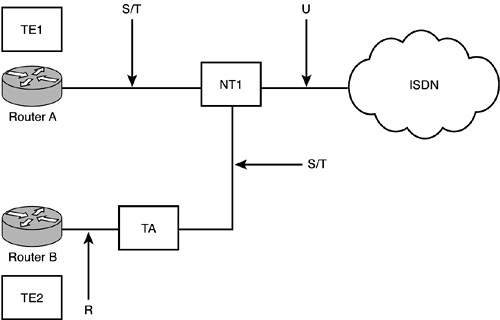ISDN Overview
| ISDN refers to the call-processing system that enables voice, data, and video to be transmitted over our existing telephone system. ISDN offers several advantages over existing analog modem lines. For example, ISDN connection speeds begin at 64Kbps, whereas typical modem speeds hover between 28.8Kbps and 56Kbps. The call setup time for an ISDN call is also much quicker. ISDN can transmit data packets, voice, or video. ISDN is a viable solution for remote connectivity ( telecommuting ) and access to the Internet. ISDN also supports any of the Network layer protocols supported by the Cisco Internetwork Operating System (IOS) and encapsulates other WAN services, such as PPP.
Basic Rate Interface and Primary Rate InterfaceISDN can be ordered as either BRI or PRI. An ISDN BRI service contains two bearer channels (or B channels) of 64Kbps and one data channel (or D channel) of 16Kbps. The B channel carries user data, and the D channel carries signaling and control information. The maximum throughput for BRI is 128Kbps (two B channels at 64Kbps). In North America and Japan, an ISDN PRI service uses a T1 line that contains 23 B channels and one D channel, enabling a maximum throughput of 1.544Mbps. In Europe, PRI service uses an E1 line that contains 30 B channels and 1 D channel, enabling a throughput of 2.048Mbps. ISDN, like other communications services, requires Data Terminal Equipment ( DTE ) and Data Communications Equipment ( DCE ) . In most cases you will be connecting a router to the ISDN BRI service and that router will have an ISDN BRI interface. The interface can either be built in to the router's circuitry or take the form of a module added to the router. Sometimes you will see the term "TE1" (terminal equipment one) applied to routers without an interface and "TE2" used for routers including the interface. In either case, that interface is the Data Terminal Equipment (DTE) and in the world of ISDN BRI it is called a Terminal Adapter ( TA ) . The Data Communications Equipment that connects to the local loop of the service provider is called a Network Termination One (NT1) . The NT1 provides clocking and conversion of data into a suitable format for transmission across the local loop. In North America, the service provider usually provides the NT1 (but not always) and the user is responsible for providing power to the NT1. Physically, the router's Terminal Adapter connects to the NT1 via a cable and the NT1 connects to the local loop (see Figure 4.4). Figure 4.4. Interface devices used with ISDN. ISDN PRI service has 23 bearer channels so it uses a larger ISDN PRI specific DCE called a Data Service Unit and Channel Service Unit (DSU/CSU). The DSU provides clocking and conversion of data while the CSU splits out the channels for use by the Data Communications Equipment.
DDRDial-on-demand routing ( DDR ) works with ISDN to establish and terminate network connections, as traffic dictates. DDR configuration commands define host and ISDN connection information. An access list and DDR dialer group define what type of traffic should initiate an ISDN call. You can configure multiple access lists to look for different types of "interesting" traffic ”network traffic that, when it arrives at the router, triggers the router to initiate the ISDN connection. When the router notices interesting traffic, it refers to its ISDN information and initiates the setup of the ISDN call through its BRI or PRI and NT1 device. It should also be noted here that 56Kbps dial-up interfaces can also be used with DDR. When the connection is established, normal routing occurs between the two end devices. After interesting traffic stops being transmitted over the ISDN connection, the connection idle timer begins. When the idle timer expires , the connection is terminated . |
EAN: N/A
Pages: 155
